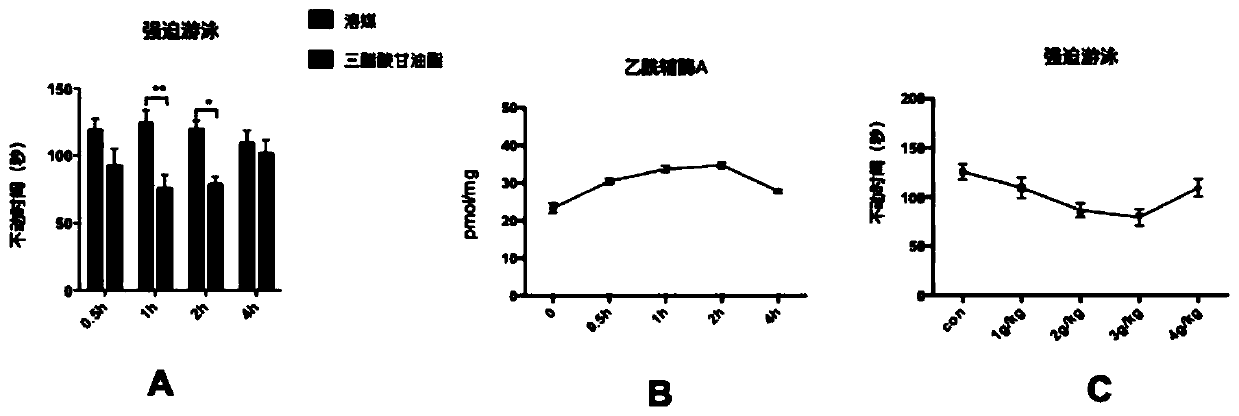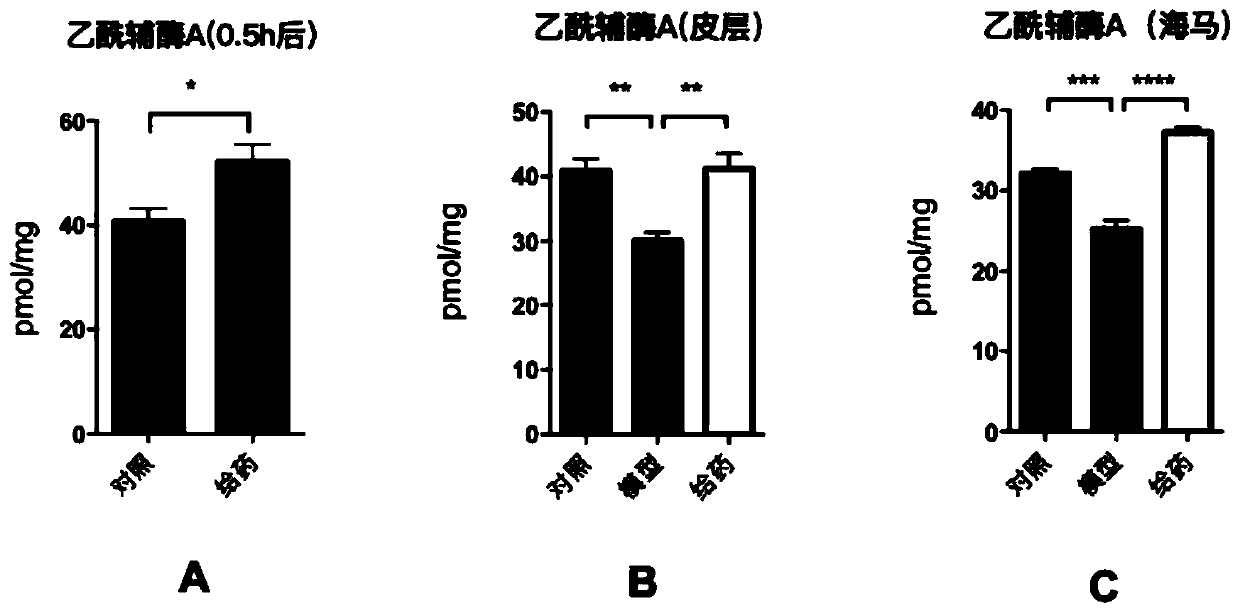Application of glycerol triacetate to preparation of medicines for preventing and treating depression
A technology of glyceryl triacetate and depression, which is applied in the direction of drug combinations, active ingredients of esters, nervous system diseases, etc., can solve the problems of slow onset of effect, large side effects, lack of treatment methods, etc., and achieve the prevention and treatment of depression, depression, The effect of improving depression-like behavior
- Summary
- Abstract
- Description
- Claims
- Application Information
AI Technical Summary
Problems solved by technology
Method used
Image
Examples
Embodiment 1
[0028] Example 1 GTA acute administration antidepressant experiment.
[0029] 8-10 week-old clean-grade healthy male C57 mice were supplemented with GTA (3g / kg) for 0.5h, 1h, 2h, and 4h, and their performance in forced swimming was detected immediately, and then the hippocampal tissue of the mouse brain was harvested. The results showed that the administration group was compared with the control group, such as figure 1 -A, Immobility time in forced swimming was significantly reduced after GTA (3g / kg / d) supplementation for 1h and 2h; as figure 2 -B, and the level of acetyl-CoA in the hippocampus reached its peak after supplementing GTA (3g / kg / d) for 1h and 2h; figure 1 -C is 8-10 weeks old clean-grade healthy male C57 mice were given GTA 1g / kg, 2g / kg, 3g / kg, 4g / kg and immediately detected their performance in forced swimming, the results showed that when the dose When it was 3g / kg, the immobility time of mice in forced swimming was the shortest.
Embodiment 2
[0030] Example 2 Preventive GTA supplementation antidepressant experiment.
[0031] Such as figure 2 -A, the level of acetyl-CoA in the prefrontal cortex of the mice after half an hour of exogenous supplementation of GTA (administration) in clean-grade healthy male C57 mice at the age of 8-10; figure 2 -B and figure 2 -C, The level of acetyl-CoA in the prefrontal cortex and hippocampus of mice susceptible to social stress (model) was significantly reduced, while the level was roughly restored to normal after exogenous supplementation of GTA (administration).
[0032] 60 clean healthy male C57BL / 6J mice aged 8-10 weeks, weighing 22±2g, were randomly divided into 4 groups, 15 mice in each group, respectively blank control group, depression model group, depression model + GTA group, depression model group Model + fluoxetine group. Such as image 3 As shown in -A, the four groups of animals were given the corresponding drugs by intragastric administration, once a day, for 1...
Embodiment 3
[0036] Example 3 Therapeutic Supplement GTA Antidepressant Experiment.
[0037] 8-10 weeks old clean grade healthy male C57BL / 6J mice were induced to exhibit depression-like behavior through social stress model, such as Image 6 -A, after 3 days of therapeutic supplementation of GTA (3g / kg / d) to depressed mice, the depression-like behavior of the mice was detected on the 4th day. On the 22nd day, the hippocampus tissue samples were collected for Golgi staining and western blotting.
[0038] The depressive-like behavior of the mice was detected on the 4th day, and the results showed that the depressive-like behavior of the depressed mice was improved after therapeutic GTA supplementation, as shown in Image 6 Decreased time spent immobilized in the forced swim test (FST) as indicated by -D; as Image 6 As shown by -E, there is an enhancement of sugar water preference; as Image 6 -F, Image 6 -G shows that the percentage of time spent in the central area increased and the p...
PUM
 Login to View More
Login to View More Abstract
Description
Claims
Application Information
 Login to View More
Login to View More - R&D
- Intellectual Property
- Life Sciences
- Materials
- Tech Scout
- Unparalleled Data Quality
- Higher Quality Content
- 60% Fewer Hallucinations
Browse by: Latest US Patents, China's latest patents, Technical Efficacy Thesaurus, Application Domain, Technology Topic, Popular Technical Reports.
© 2025 PatSnap. All rights reserved.Legal|Privacy policy|Modern Slavery Act Transparency Statement|Sitemap|About US| Contact US: help@patsnap.com



